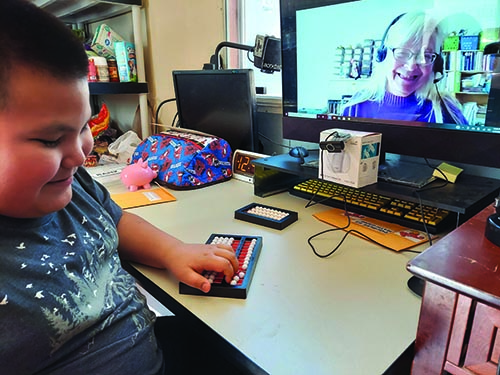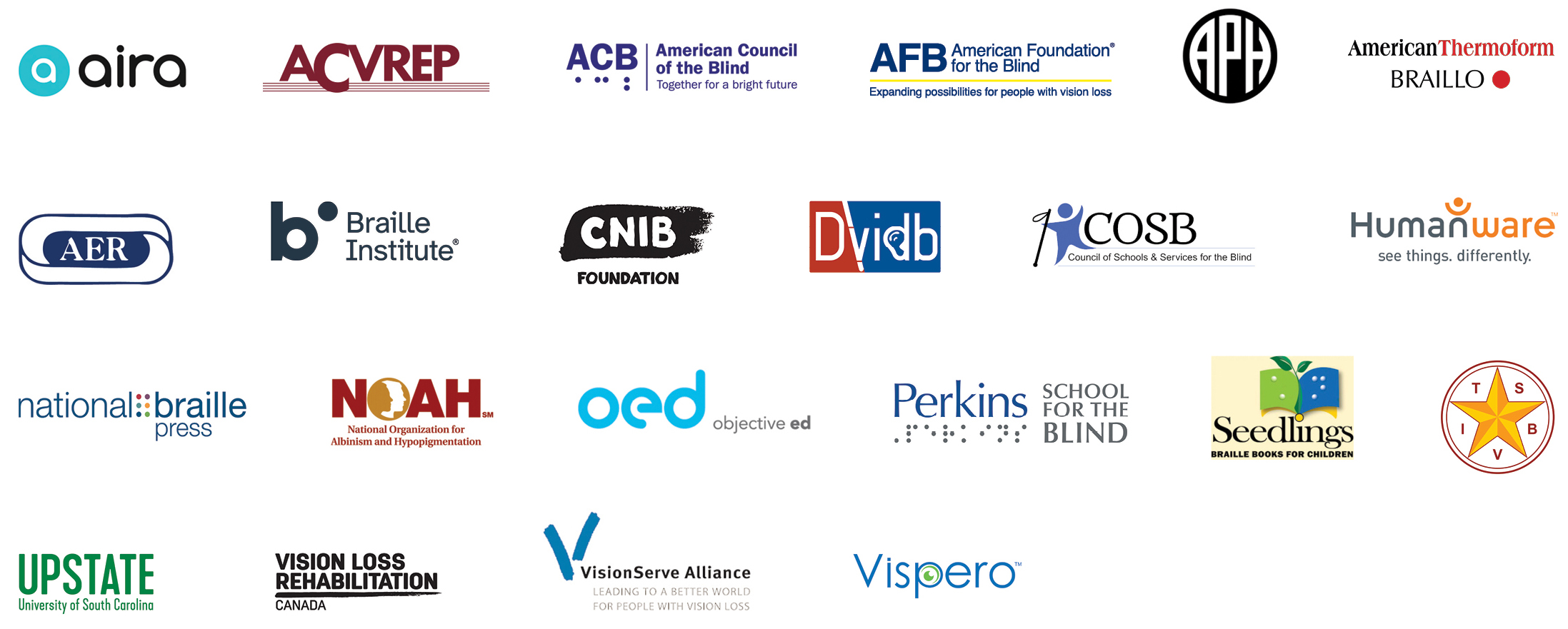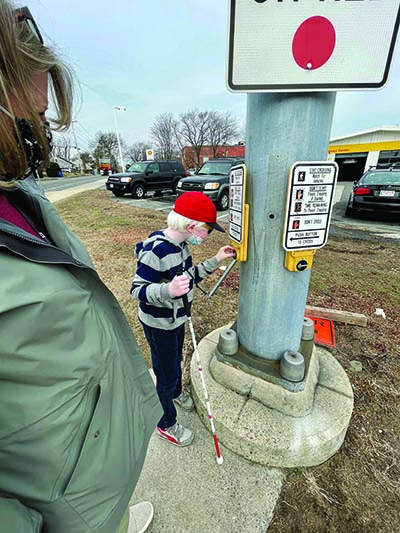Authors
L. Penny Rosenblum | Paola Chanes-Mora | Danene Fast | Justin T. Kaiser | Tiffany Wild | Tina S. Herzberg | Carlie R. Rhoads | Kathryn D. Botsford | Jasmyn N. DeGrant | Michelle A. C. Hicks | Leanne K. Cook | Stephanie Welch-Grenier
Acknowledgements
When we collected data for the first Access and Engagement study in spring 2020, we believed that by the start of the 2020–2021 school year, education would be back to normal or at least close to it. This was not the case, and so our research team decided a fall 2020 study was needed so we could document the continued impact of COVID-19 on the education of children with visual impairments. The research team was comprised of Dr. L. Penny Rosenblum (Director of Research, American Foundation for the Blind), Dr. Paola Chanes-Mora (Policy Research Specialist, American Foundation for the Blind), Dr. Danene Fast (Clinical Assistant Professor, The Ohio State University), Dr. Justin T. Kaiser (Clinical Assistant Professor, University of Kentucky), Dr. Tiffany Wild (Associate Professor, The Ohio State University), Dr. Tina S. Herzberg (Professor, University of South Carolina Upstate), Dr. Carlie R. Rhoads (Research Specialist, American Foundation for the Blind), Dr. Kathryn D. Botsford (Digital Content Strategist, American Printing House for the Blind), Jasamyn Nichols DeGrant (Graduate Student, University of Kentucky), Leanne K. Cook (TVI, Portland Public Schools-Columbia Regional Program), Michelle A. C. Hicks (Doctoral Student, Virginia Commonwealth University), and Stephanie Welch-Grenier (Doctoral Student, The Ohio State University).
Two interns, Shriti Jaiswal and Mignon du Plessis, assisted Dr. Chanes-Mora and other members of the team in completing the quantitative data analysis. Ms. Hannah Jacobus worked on the project for a short time. Rishika Kartik assisted Dr. Rosenblum with numerous tasks during the data analysis and development of the report.
We appreciate the family members and professionals who shared photographs with us so that we can show not only in words, but in pictures, what education looks like for students with visual impairments during the COVID-19 pandemic.
We appreciate the AFB staff members who dedicated time and made financial contributions to the development of this report.
Thank you to the organizations that shared information about the study and to the many individuals who took the time to complete the survey.
Suggested Citation
Rosenblum, L. P., Chanes-Mora, P., Fast, D., Kaiser, J. T., Wild, T., Herzberg, T. S., Rhoads, C. R., Botsford, K. D., DeGrant, J. N., Hicks, M. A. C., Cook, L. K., & Welch-Grenier, S. (2021). Access and Engagement II: An Examination of How the COVID-19 Pandemic Continued to Impact Students with Visual Impairments, Their Families, and Professionals Nine Months Later, American Foundation for the Blind.
Collaborating Organizations
The following 22 organizations, companies, and universities collaborated with the Access and Engagement II team. Through their commitment to this project, we were able to widely share information about the study.
- Academy for Certification and Education of Vision Rehabilitation Professionals
- Aira Tech Corp
- American Council of the Blind
- American Foundation for the Blind
- American Printing House for the Blind
- American Thermoform
- Association for Education and Rehabilitation of the Blind and Visually Impaired
- Braille Institute
- CNIB Foundation
- Council for Exceptional Children’s Division on Visual Impairment and Deafblindness
- Council of Schools and Services for the Blind
- Humanware
- National Braille Press
- National Organization for Albinism and Hypopigmentation
- Objective Ed
- Perkins School for the Blind
- Seedlings Braille Books for Children
- Texas School for the Blind and Visually Impaired
- University of South Carolina Upstate, Visual Impairment Program
- Vision Loss Rehabilitation Canada
- VisionServe Alliance
- Vispero
Terminology
The following terms are used in the report:
(Note: These definitions are not comprehensive but cover the ways the terms are used in this report.)
504 Plan: A legal plan that outlines the accommodations or supports students in the U.S. education system receive based on their specific needs. A 504 Plan does not provide for specialized instruction or consultation in the same way an Individualized Education Program (IEP) does.
Accessible information: Information that can be accessed via screen reader software, magnification, braille, audio description, captioning, sign languages (e.g., ASL, Signed English), visual interpreters, and support service providers. For example, maps, charts, and images may be accessible if they include a text description of visual content, large fonts, and high-contrast colors in the design.
Assistive technology: Products, equipment, and systems that enhance learning, education, and daily living for individuals with disabilities.
Digital learning tools: Websites, apps, learning management systems, and file storage systems used in education. Common examples include Google Docs, iReady, and Canvas.
Expanded Core Curriculum (ECC): A framework that includes nine areas of instruction in which many students with visual impairments require direct instruction. Areas of the ECC include compensatory skills, orientation and mobility, social interaction, independent living, recreation and leisure, sensory efficiency, assistive technology, career education, and self-determination.
Family member: Family member refers to the person completing the survey responsible for the care of the child. In the survey, the term family member/guardian was used.
Hybrid instruction: This instructional model is a combination of in-person and online learning that blends into one cohesive learning experience. Hybrid instruction may vary in implementation depending on the location and school district.
Individualized Education Program (IEP): An IEP is a written document developed by the educational team that describes the child’s current strengths and needs, goals for the coming year, services to be provided, and accommodations needed by the child to access the curriculum. Other components include the individual(s) responsible for providing services, where the services will be delivered, and if the child will receive braille instruction.
Individualized Family Service Plan (IFSP): An IFSP is a written document for children birth to age 3 years and developed with the family. The IFSP focuses on the child’s development and family’s needs; it outlines goals for the family and the individuals and supports necessary for the family to achieve the goals. IFSPs must be reviewed every 6 months.
Online instruction: This instructional model, sometimes referred to as remote, virtual, or distance instruction, occurs when students and educators meet using a program such as Zoom, FaceTime, or Microsoft Teams.
Orientation and mobility (O&M): One’s ability to travel safely and efficiently through one’s environment.
Orientation and mobility specialist: A trained professional who teaches travel skills to individuals who are visually impaired.
School-age students: Students in kindergarten through 12th grade as well as students in transition programs who may have graduated or received a certificate of completion but are still eligible for services under IDEA in the United States or their provincial authority in Canada.
Screen magnification software: Software that allows low vision users to adjust the size of the screen content and select alternative background/font combinations to make viewing content easier.
Screen reader software: Software that converts text to speech and allows the individual to use keyboard commands when using a mouse is not possible or efficient.
Social or physical distancing: The practice of maintaining at least 6 feet between one’s self and others to minimize COVID-19 spread.
Visually impaired (VI): Description applied in this report to individuals who are blind or have low vision unless specific information is provided related to either blindness or low vision.
Vision professional: Teachers of students with visual impairments (TVIs), orientation and mobility (O&M) specialists, and dually certified professionals are referred to as vision professionals in this report.
Abbreviations
The following abbreviations are used throughout this report:
AFB: American Foundation for the Blind
APH: American Printing House for the Blind
CVI: cortical visual impairment
ECC: expanded core curriculum
EI: early intervention
IDEA: Individuals with Disabilities Education Act
IEP: Individualized Education Program
IFSP: Individualized Family Service Plan
O&M: orientation and mobility
PS: preschool
SA: school-age
TVI: teacher of students with visual impairments
VI: visually impaired




